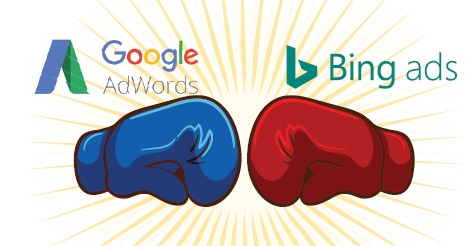If you’re planning to promote your business using pay-per-click (PPC) ads, you’ll need to choose the right PPC platform. Not surprisingly, Google Ads and Bing Ads are the most popular platforms among business owners and marketers. The former was launched by Google in 1999 under the brand name AdWords, whereas Microsoft launched Bing Ads in 2006 under the brand name adCenter. They both feature a similar web-based interface for creating and managing PPC ads.
Reach
With Google processing more than 1.2 trillion searches per year, Google Ads offers the most extensive reach. You can target Google’s search results, Shopping, Maps and search partner websites using the Search Network. Alternatively, you can focus on more than 2 million affiliated sites, including YouTube, Gmail and AdSense websites, using the Google Ads Display Network. According to Google, the Display Network reaches 90 percent of all internet users, making it a near-limitless source of traffic. But even if you only use the Search Network, generating ad impressions and clicks shouldn’t be a problem.
Bing Ads may lack the reach of Google Ads, but you shouldn’t discount it from your marketing strategy. Microsoft has worked aggressively in recent years to build Bing’s brand image and encourage people to use its search engine. In 2010, Bing accounted for only 11 percent of all searches performed in the United States. As of 2018, the Microsoft-owned search engine accounts for nearly one one-third of all U.S. searches. That is partly due to Microsoft’s acquisition of Yahoo in 2008 for $44.6 billion, allowing it to include Yahoo Search in the Bing Ads network.
Cost
When creating ads for either Bing Ads or the Google Ads Search Network, you’ll need to specify the maximum amount that you are willing to pay for clicks triggered by each of your target keywords. Known as a maximum cost-per-click (CPC) bid, this will determine the cost of your advertising campaign. For each ad click, Bing Ads and the Google Search Network will charge you no more than your maximum CPC bid.
You’ll probably find that ad clicks are cheaper on Bing Ads than Google Ads, however. According to a study conducted by Search Engine People, clicks for automotive-related Bing Ads were almost 33 percent less expensive than clicks for the same type of ads on Google. For insurance-related Bing Ads, clicks were 59.2 percent cheaper.
Conversion Rate
Click costs is an important metric to monitor when advertising on Google Ads or Bing Ads. Even more important, though, is conversion rate, which is the percentage of users who buy your product or service after seeing your ad. When compared to other marketing verticals (e.g., email, social media, direct mail, television, radio, etc.), Google Ads and Bing Ads offer some of the highest conversion rates. But many marketers have found Bing Ads to deliver higher conversion rates than its counterpart. In its study, Search Engine People reported 10 percent to 50 percent higher conversion rates with automotive-related Bing Ads.
Ad Review Time
Whether you use AdWords or Bing Ads, you won’t have to wait long to get your ads reviewed. AdWords typically reviews new and modified ads within 24 to 72 hours, Bing Ads within 48 to 72 hours. Once approved, your ad will begin to show on the respective platform for your target keywords. If either platform rejects your ad, you must modify it to comply with guidelines. Otherwise, it remains stuck in limbo.
Keyword Match Types
Both Google Ads and Bing Ads offer a variety of keyword match types, including broad, phrase, negative and exact matches. Although the specifics vary between the different PPC platforms, the broad match is the most generalized option as it triggers ads when a user searches for the specified keyword as well as related keywords. Phrase match is a more targeted option that only triggers ads when a user searches for the keyword or a close variation. Exact match is the most targeted option, with ads triggered only by an exact keyword or a very close variation. A negative match, on the other hand, prevents triggering for a user’s search query containing that keyword.
Video
When it comes to video marketing, Google Ads has the advantage over Bing Ads because only it supports video as an ad format. Using the Google Ads Display Network, you can create video ads for YouTube and other Google-affiliated websites. Bumper ads, for example, are non-skippable six-second video ads that play at the beginning, middle or end of another video. Unlike Search Network ads, bumper ads cost a flat rate for every 1,000 views, known as cost per impression (CPM). There are also TrueView ads, which are longer video ads that viewers can skip by clicking a button. With TruView ads, you only get charged when a viewer interacts with your video or watches at least 30 seconds of it.
Mobile Targeting
Given the rise of mobile web browsing in recent years — more than 60 percent of all internet searches are now performed on smartphones and tablets — many marketers want only to target mobile users with PPC ads. That isn’t a problem with either Google Ads and Bing Ads. You can create mobile-only campaigns for both platforms by using the bid adjustment feature. Making a -100 percent bid adjustment for desktop devices, for example, essentially prevents your ads from displaying to users on a desktop computer. Only smartphone and tablet users will see your ads with this adjustment.
With its unparalleled reach and support for rich media formats, Google Ads will likely remain the most popular PPC platform. However, Bing Ads is gaining momentum in the PPC marketplace, and for a good reason. It supports many of the same features as Google Ads while delivering lower click costs and higher conversion rates in the process. So, rather than exhausting your budget on Google Ads, diversify your marketing strategy by including Bing’s PPC platform.








